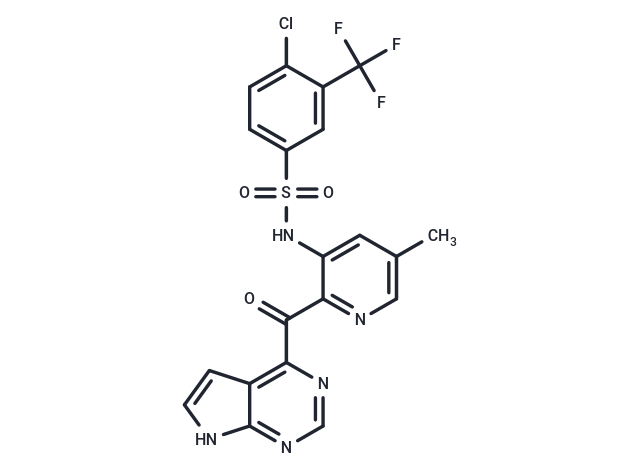Shopping Cart
- Remove All
 Your shopping cart is currently empty
Your shopping cart is currently empty

CCX140 (CCX140-B) (CCX140-B) is an antagonist of CCR2.

| Pack Size | Price | Availability | Quantity |
|---|---|---|---|
| 2 mg | $50 | In Stock | |
| 5 mg | $62 | In Stock | |
| 10 mg | $92 | In Stock | |
| 25 mg | $138 | In Stock | |
| 50 mg | $205 | In Stock | |
| 100 mg | $308 | In Stock | |
| 1 mL x 10 mM (in DMSO) | $72 | In Stock |
| Description | CCX140 (CCX140-B) (CCX140-B) is an antagonist of CCR2. |
| Targets&IC50 | CCR2:3 nM (in THP-1 cells), CCR2 (human):2.3 nM (kd)(in monocytes), CCR5:7 μM (in Activated T lymphocytes) |
| In vitro | CCX140 inhibits the binding of 125I-CCL2 to monocytes with an IC50 value of 17 nM and it also inhibits CCL2-induced Ca2+ mobilization in monocytes with an IC50 value of 3 nM. CCX140 (CCX140-B) potently inhibits CCL2-induced chemotaxis of purified human blood monocytes with IC50 values of 8 nM in buffer and 200 nM in the presence of 100% human serum. CCX140 has a Kd value of 2.3 nM toward hCCR2. CCX140 also inhibits monocyte chemotaxis mediated by the other CCR2 ligands: CCL8/MCP-2, CCL7/MCP-3, and CCL13/MCP-4[1]. |
| In vivo | CCX140 effectively moderates various metabolic and immunological parameters. It decreases urine and glucose excretion, lowers hepatic glycogen and triglyceride contents, and reduces glucose 6-phosphatase levels. In hCCR2 KI mice, CCX140-B dosage exhibits a significant, dose-dependent capability to mitigate peritoneal leukocyte count following thioglycollate induction, displaying robust leukocyte infiltration inhibition at 30 mg/kg, partial inhibition at 10 mg/kg, and no effect at 3 mg/kg. Additionally, in diet-induced obese (DIO) mice, CCX140 acts as a CCR2 antagonist, fully preventing inflammatory macrophage recruitment to visceral adipose tissue. For DIO hCCR2 KI mice treated with 100 mg/kg of CCX140, there's an evident halt in the escalating urine albumin excretion rate (UAER) and albumin to creatinine ratio (ACR), with sustained lower levels throughout an 8-week dosage period. The treated mice also show reduced hyperglycemia and insulin levels, enhanced insulin sensitivity, escalated circulating adiponectin levels, diminished pancreatic islet size, and an increase in islet number, demonstrating CCX140's comprehensive therapeutic potential. |
| Alias | CCX140-B |
| Molecular Weight | 495.86 |
| Formula | C20H13ClF3N5O3S |
| Cas No. | 1100318-47-5 |
| Smiles | Cc1cnc(C(=O)c2ncnc3[nH]ccc23)c(NS(=O)(=O)c2ccc(Cl)c(c2)C(F)(F)F)c1 |
| Relative Density. | 1.596 g/cm3 (Predicted) |
| Storage | keep away from direct sunlight | Powder: -20°C for 3 years | In solvent: -80°C for 1 year | Shipping with blue ice. |
| Solubility Information | H2O: 0.25 mg/mL (0.50 mM), Sonication and heating are recommended. DMSO: 100 mg/mL (201.67 mM) |

Copyright © 2015-2024 TargetMol Chemicals Inc. All Rights Reserved.